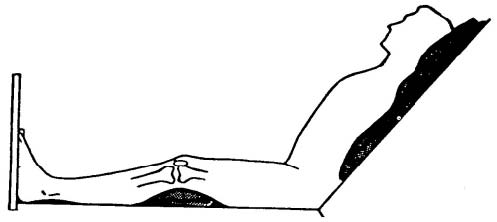 This is the Archived Desktop Edition.
This is the Archived Desktop Edition.
You should be transferred to the Newest Edition for Desktop and Mobile within 2 seconds.
Basic Patient Care Procedures
2-8
2-8. POSITION SUPPORT DEVICES
Position support devices are used to maintain good body alignment and aid comfort for bed patients. The more common support devices on the nursing unit include the adjustable Gatch bed, footboards, pillows, sandbags, and rolled and folded towels, sheets, and blankets.
a. Requirements. Any position support device should meet the following requirements.
(1) Promote good posture and conform to the part of the body being supported.
(2) Be firm enough to support the part, yet not cause undue pressure.
(3) Be of sufficient size to support a part along its entire length.
(4) Be clean and protected against moisture and body secretions.
b. Use of Support Devices. The reason for using a device should be explained to the patient. He should be encouraged to participate to the extent possible in maintaining good body alignment. Following is a description of the more common devices.
(1) The Gatch bed. Raising and lowering the back and knee rests on the adjustable Gatch bed provides support and allows for position changes, but there are disadvantages that must be considered. When the back rest is elevated, the patient tends to slide down in bed, with his body weight concentrated on the base of his spine. This is undesirable. Elevation of the knee rest counteracts this to some extent, but continued use of the knee rest causes undesirable pressure in the popliteal space (behind the knee) and can lead to restrictions in the range movement of the knee and hip. The Gatch bed should be used for variations in position and not as a substitute for active movement of the patient.
(2) The footboard. When properly placed in relation to the patient's feet, the footboard helps prevent foot drop (plantar flexion). The patient's feet should be supported at right angles to the legs then he lies on his back. A padded board, a firm pillow, or a blanket roll is braced between the end of the bed and the patient's feet.
Such a device also helps prevent the patient from sliding down in the bed, relieves the pressure of bedding on the toes, and provides a resistant surface against which the patient can push for exercise to maintain circulation and muscle tone. The board or pillow roll should extend higher than the toes (figure 2-24).
(3) Pillows. These have multiple uses, but placement in relation to body curves is essential. The standard-size pillow is often too large, but folded bath towels placed in a pillowcase can be substituted when small, firm pillow support is recommended. When the patient is supine or has the back rest elevated, the pillow supporting the head should start well under the shoulders. (A common mistake is to tuck the pillow behind the neck, forcing the head forward.) When pillows are used to elevate a limb, they should be placed so that the entire limb is supported. Two or more pillows may be required. It is important to remember that, unless otherwise ordered, the foot or hand should be slightly higher than the rest of the limb. Arrange the pillows in order to provide an inclined plane. In moving an injured arm or leg, place both hands beneath the injured limb, at the joints above and below injury. Raise the limb slowly and gently and place it on the supporting pillow or pillows. Figure 2-25 illustrates the leg and arm supported in abduction with pillows covered by sheets. The head is supported with a small pillow (figure 2-26).
A. Feet supported with board or weighted box. Knee flexion maintained with small pillows. Shoulders and head supported with small pillow starting well under shoulders.
B. Feet supported with covered board or weighted box. Slight flexion of knee maintained with a folded bath towel or folded pillow. Lumbar position region supported with small pillow.
C. Heels placed against board support ankle joint with folded bath towel. Abdomen supported with firm small pillow. Shoulder supported with folded bath towel.
Figure 2-24. The footboard.
Figure 2-25. Positioning an injured leg.
Figure 2-26. Leg and arm supported in abduction.





